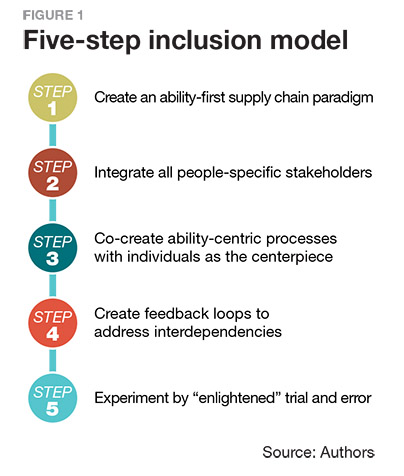Sorry, but your login has failed. Please recheck your login information and resubmit. If your subscription has expired, renew here.
November 2019
We hear a lot about emerging technologies like artificial intelligence, machine learning and robotics. We hear less about one of the enabling technologies that makes the others possible: Browse this issue archive.Need Help? Contact customer service 847-559-7581 More options
Ken is an expert at sewing. He is also blind. He can do this with the help of a set of guides designed to allow him to undertake a complex stitching process without the fear of injury or under performance. Ken can also remove extraneous thread in garments with the help of specially designed machinery containing a poka-yoke—a Japanese term referring to a mechanism that helps an equipment operator avoid mistakes and prevent injury that can happen because of missteps resulting from his lack of vision. While rare in the present-day corporate workplace, Ken’s story is relatively common in the community rehabilitation programs run by Peckham Inc., a Lansing, Michigan-based nonprofit community vocational rehabilitation organization that actively seeks to employ individuals with disabilities (see sidebar). It may also be an example for companies in search of a source of reliable talent for their supply chains.
 It’s important to note that Ken’s opportunity is facilitated by inexpensive technology and automation tools developed inhouse at Peckham. If you’re wondering how such examples might become commonplace, or how organizations can set up supply chain environments that can include individuals with a diversity of disabilities, you’re not alone. These are questions that are on the minds of senior leadership in several firms we have spoken to during the course of our research. Based on the experience of Peckham, and other organizations that have employed individuals with disabilites, it’s clear that addressing inclusion in work environments requires a systematic approach to understand the processes for working with individuals with disabilities. In this article, we discuss such a framework.
It’s important to note that Ken’s opportunity is facilitated by inexpensive technology and automation tools developed inhouse at Peckham. If you’re wondering how such examples might become commonplace, or how organizations can set up supply chain environments that can include individuals with a diversity of disabilities, you’re not alone. These are questions that are on the minds of senior leadership in several firms we have spoken to during the course of our research. Based on the experience of Peckham, and other organizations that have employed individuals with disabilites, it’s clear that addressing inclusion in work environments requires a systematic approach to understand the processes for working with individuals with disabilities. In this article, we discuss such a framework.
With the tightening labor market, the need for inclusion in managing supply chain talent has never been more critical, particularly since individuals with disabilities are an underemployed pool. To be inclusive, organizations need to carefully evaluate and delineate approaches they take to maximize the potential of individuals with disabilities. While methods and processes have evolved significantly over time, firms need to consider their approach to employing individuals with disabilities and set up organizational strategies to put abilities first. Figure 1 above presents a five-step framework that puts abilities first.

This complete article is available to subscribers only.
Log in now for full access or start your PLUS+ subscription for instant access.
SC
MR
Sorry, but your login has failed. Please recheck your login information and resubmit. If your subscription has expired, renew here.
November 2019
We hear a lot about emerging technologies like artificial intelligence, machine learning and robotics. We hear less about one of the enabling technologies that makes the others possible: Browse this issue archive. Access your online digital edition. Download a PDF file of the November 2019 issue.Ken is an expert at sewing. He is also blind. He can do this with the help of a set of guides designed to allow him to undertake a complex stitching process without the fear of injury or under performance. Ken can also remove extraneous thread in garments with the help of specially designed machinery containing a poka-yoke—a Japanese term referring to a mechanism that helps an equipment operator avoid mistakes and prevent injury that can happen because of missteps resulting from his lack of vision. While rare in the present-day corporate workplace, Ken's story is relatively common in the community rehabilitation programs run by Peckham Inc., a Lansing, Michigan-based nonprofit community vocational rehabilitation organization that actively seeks to employ individuals with disabilities (see sidebar). It may also be an example for companies in search of a source of reliable talent for their supply chains.
 It's important to note that Ken's opportunity is facilitated by inexpensive technology and automation tools developed inhouse at Peckham. If you're wondering how such examples might become commonplace, or how organizations can set up supply chain environments that can include individuals with a diversity of disabilities, you're not alone. These are questions that are on the minds of senior leadership in several firms we have spoken to during the course of our research. Based on the experience of Peckham, and other organizations that have employed individuals with disabilites, it's clear that addressing inclusion in work environments requires a systematic approach to understand the processes for working with individuals with disabilities. In this article, we discuss such a framework.
It's important to note that Ken's opportunity is facilitated by inexpensive technology and automation tools developed inhouse at Peckham. If you're wondering how such examples might become commonplace, or how organizations can set up supply chain environments that can include individuals with a diversity of disabilities, you're not alone. These are questions that are on the minds of senior leadership in several firms we have spoken to during the course of our research. Based on the experience of Peckham, and other organizations that have employed individuals with disabilites, it's clear that addressing inclusion in work environments requires a systematic approach to understand the processes for working with individuals with disabilities. In this article, we discuss such a framework.
With the tightening labor market, the need for inclusion in managing supply chain talent has never been more critical, particularly since individuals with disabilities are an underemployed pool. To be inclusive, organizations need to carefully evaluate and delineate approaches they take to maximize the potential of individuals with disabilities. While methods and processes have evolved significantly over time, firms need to consider their approach to employing individuals with disabilities and set up organizational strategies to put abilities first. Figure 1 above presents a five-step framework that puts abilities first.
SC
MR


Latest Supply Chain News
- Despite American political environment, global geopolitical risks may be easing
- Joseph Esteves named CEO of SGS Maine Pointe
- Employees, employers hold divergent views on upskilling the workforce
- April manufacturing output slides after growing in March
- Q1 sees a solid finish with positive U.S.-bound import growth, notes S&P Global Market Intelligence
- More News
Latest Podcast

 Explore
Explore
Business Management News
- Joseph Esteves named CEO of SGS Maine Pointe
- Employees, employers hold divergent views on upskilling the workforce
- April manufacturing output slides after growing in March
- Q1 sees a solid finish with positive U.S.-bound import growth, notes S&P Global Market Intelligence
- 6 Questions With … Sandeep Bhide
- MIT CTL offering humanitarian logistics course
- More Business Management
Latest Business Management Resources

Subscribe

Supply Chain Management Review delivers the best industry content.

Editors’ Picks






